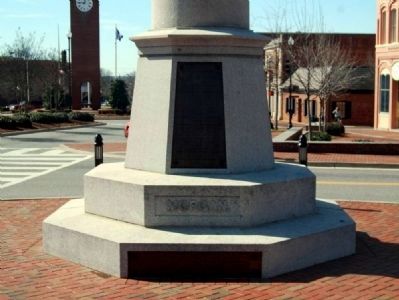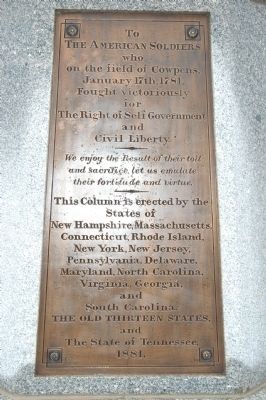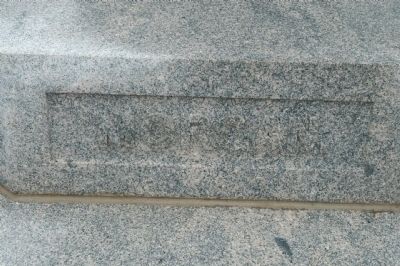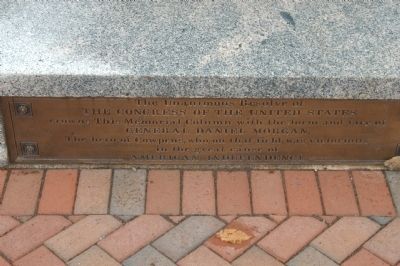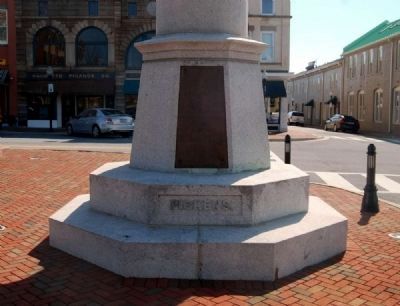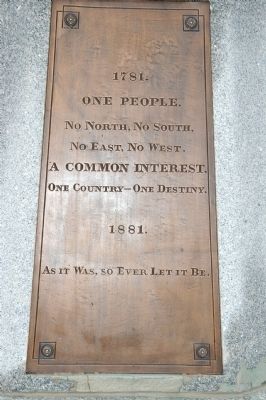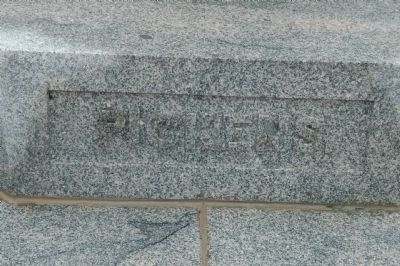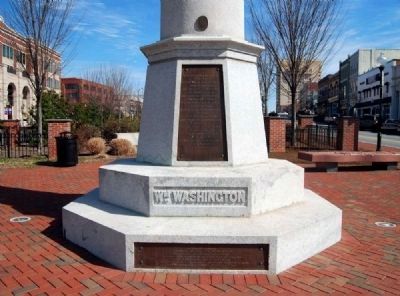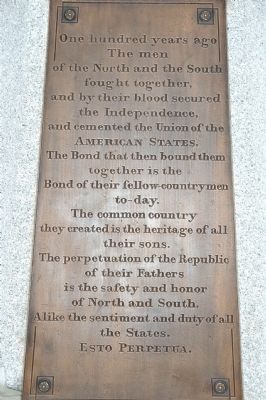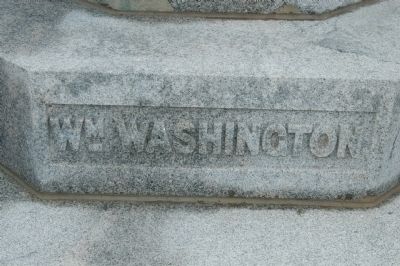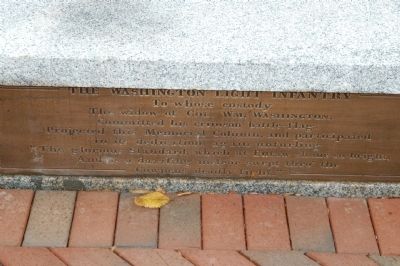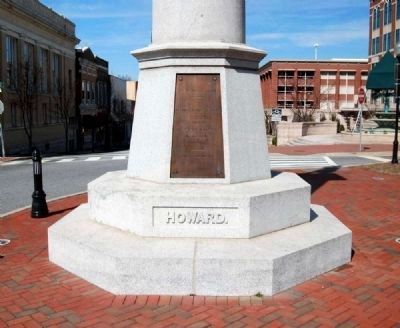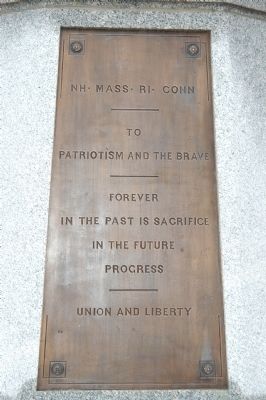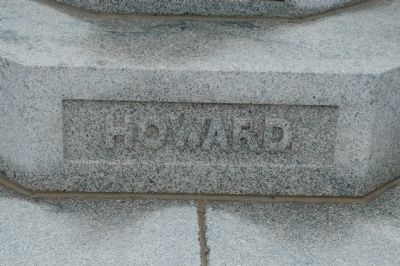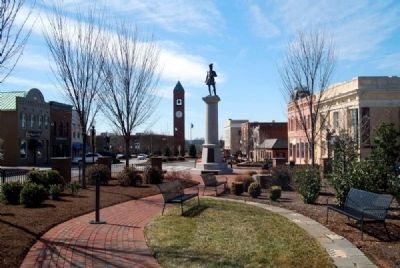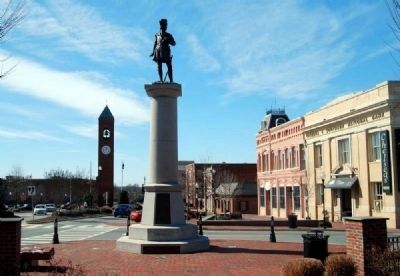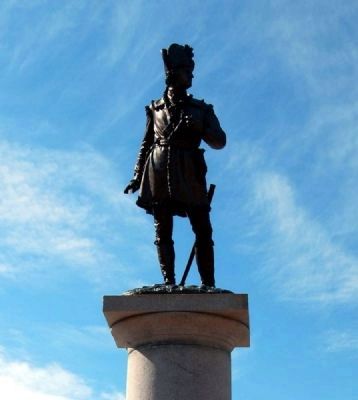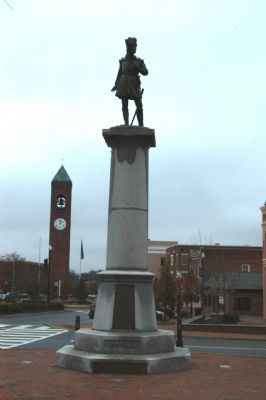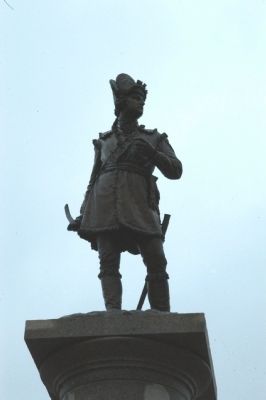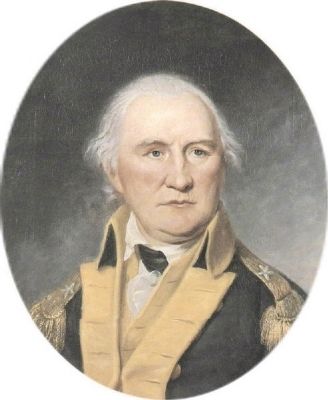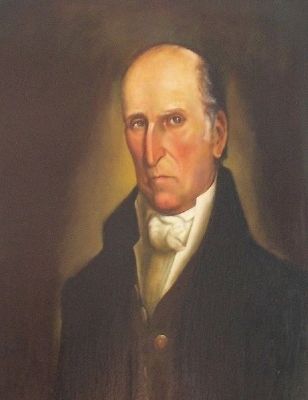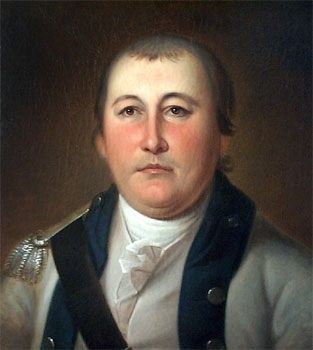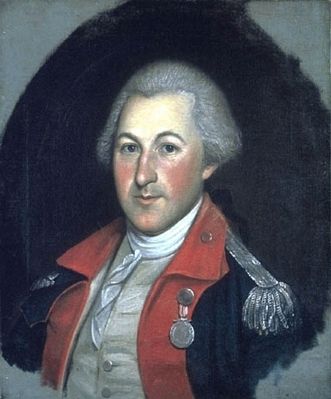Spartanburg in Spartanburg County, South Carolina — The American South (South Atlantic)
Daniel Morgan Monument
[Morgan Side Top]
the American Soldiers
who
on the field of Cowpens,
January 17th, 1781,
fought victoriously
for
The Right of Self Government
and
Civil Liberty.
————— • —————
We enjoy the Result of their toil
and sacrifice, let us emulate
their fortitude and virtue.
————— • —————
This Column is erected by the
States of
New Hampshire, Massachusetts,
Connecticut, Rhode Island,
New York, New Jersey,
Pennsylvania, Delaware,
Maryland, North Carolina,
Virginia, Georgia,
and South Carolina.
The Old Thirteen States,
and
The State of Tennessee
1881.
[Morgan Side Bottom]
the Congress of the United States
crowns this Memorial Column with the form and face of
General Daniel Morgan,
the hero of Cowpens, who, on that field, was victorious
in the great cause of
American Independence.
[Pickens Side]
One people.
No North, No South,
No East, No West.
A Common Interest.
One country-one destiny.
1881.
As it was, so ever let it be.
[William Washington Side Top]
The men
of the North and the South
fought together,
and by their blood secured
the Independence,
and cemented the Union of the
American States.
The Bond that then bound them
together is the
Bond of their fellow-countrymen
to-day.
The common country
they created is the heritage of all
their sons.
The perpetuation of the Republic
of their Fathers
is the safety and honor
of North and South.
Alike the sentiment and duty of all
the States.
Esto perpetua.
[William Washington Side Bottom]
To whose custody
the widow of Col. Wm. Washington,
committed his crimson battle-flag,
Projected this Memorial Column, and participated
in its dedication, again unfurling
"The glorious Standard, which at Eutaw shone so bright,
And as a dazzling meteor swept thro' the
Cowpens deadly fight."
[Howard Side]
——————————
To
patriotism and the brave
——————————
Forever
in the past sacrifice
in the future
progress
——————————
Union and liberty
Erected 1881 by The Thirteen Original States and Tennessee.
Topics. This historical marker and monument is listed in these topic lists: Patriots & Patriotism • War, US Revolutionary. A significant historical month for this entry is January 1400.
Location. 34° 56.964′ N, 81° 55.98′ W. Marker is in Spartanburg, South Carolina, in Spartanburg County. Marker is at the intersection of Magnolia Street and Dunbar Street, on the left when traveling south on Magnolia Street. Touch for map. Marker is in this post office area: Spartanburg SC 29306, United States of America. Touch for directions.
Other nearby markers. At least 10 other markers are within walking distance of this marker. Chaser the Border Collie (a few steps from this marker); William Walker / Clara Smith (within shouting distance of this marker); 156 West Main Street (within shouting distance of this marker); Spartanburg Town Clock (within shouting distance of this marker); Dr. Rosa H. Gantt (about 300 feet away, measured in a direct line); Spartanburg Water Works (about 300 feet away); Pink Anderson / The Marshall Tucker Band (about 400 feet away); Cantrell Wagon Building (about 500 feet away); Palmetto Building (about 600 feet away); Arthur Prysock / Ira Tucker (about 600 feet away). Touch for a list and map of all markers in Spartanburg.
Also see . . .
1. Daniel Morgan Monument. The Daniel Morgan Monument, erected in 1881 to commemorate the centennial of the victory at the Revolutionary Battle of Cowpens and its hero, General Daniel Morgan, is located in Morgan Square in downtown Spartanburg on a pedestrian island at the intersection of Main and Church Streets. (Submitted on February 18, 2011, by Brian Scott of Anderson, South Carolina.)
2. Battle of Cowpens. The Battle of Cowpens (January 17, 1781) was a decisive victory by American Revolutionary forces under Brigadier General Daniel Morgan, in the Southern campaign of the American Revolutionary War. (Submitted on February 19, 2011, by Brian Scott of Anderson, South Carolina.)
3. Cowpens National Battlefield (U.S. Park Service). A pasturing area at the time of the battle, this Revolutionary War site commemorates the place where Daniel Morgan and his army turned the flanks of Banastre Tarleton's British army. (Submitted on February 19, 2011, by Brian Scott of Anderson, South Carolina.)
4. Daniel Morgan. Daniel Morgan (1736 – July 6, 1802) was an American pioneer, soldier, and United States Representative from Virginia. (Submitted on February 18, 2011, by Brian Scott of Anderson, South Carolina.)
5. Andrew Pickens. Andrew Pickens (September 13, 1739 – August 11, 1817) was a militia leader in the American Revolution and a member of the United States House of Representatives from South Carolina. (Submitted on February 19, 2011, by Brian Scott of Anderson, South Carolina.)
6. William Washington. William Washington (February 28, 1752 to March 6, 1810), was an officer of the Continental Army during the American Revolutionary War, who held a final rank of Brigadier General in the newly created United States after the war. (Submitted on February 19, 2011, by Brian Scott of Anderson, South Carolina.)
7. John Eager Howard. John Eager Howard (June 4, 1752 – October 12, 1827) was an American soldier and politician from Maryland. (Submitted on February 19, 2011, by Brian Scott of Anderson, South Carolina.)
8. John Quincy Adams Ward. John Quincy Adams Ward (June 29, 1830 – May 1, 1910) was an American sculptor, who is most familiar for his over-lifesize standing statue of George Washington on the steps of Federal Hall on Wall Street. (Submitted on February 19, 2011, by Brian Scott of Anderson, South Carolina.)
9. Edward Brickell White. Edward Brickell White (January 1, 1806 – May 10, 1882), also known as E.B. White, was an American architect. (Submitted on February 19, 2011, by Brian Scott of Anderson, South Carolina.)
Additional commentary.
1. Daniel Morgan Monument
Erected in 1881 to commemorate the Revolutionary Battle of Cowpens and its hero, General Daniel Morgan, and standing thirty feet overall, the Daniel Morgan Monument is located in Morgan Square in downtown Spartanburg, South Carolina, on a pedestrian island at the intersection of Main and Church Streets. The heroic bronze statue which tops the monument was modeled by John Quincy Adams Ward. The state stands on a column on an octagonal base which was designed by Charleston architect Edward B. White.
The Daniel Morgan statue was cast at the foundry of Burea Brothers and Heaton of Philadelphia. The work took three months. It is nine feet high, and weighs about 2,000 pounds. The original color was a fine golden bronze which was darkened with acid, at the artist's direction, to a rich brown. Weathered has oxidized the metal to the familiar green patina of outdoor bronze statuary.
Modeled by John Quincy Adams Ward of New York, the statue was nine months in preparation. The face and dress are modeled after a portrait of Daniel Morgan by James Herring based on a sketch by Col. Trumbull and engraved by Prudhomme. The costume is a rifleman's fringed skirt, leggings and moccasins. The hat is a high cap of fur with a pompom of pine leaves on the left side. The cap is modeled after an original Revolutionary War cap loaned to Ward by a gentleman of Charleston, S.C. The ruffled shirt front, cravat, and manner of wearing the hair are all in the mode of Daniel Morgan's time. A sword sheath and belt and a sash tied at the left hip indicate the wearer's rank. A powder-horn slung to the right side indicates Morgan's preference for the rifle even though he is not carrying one. A drawn sword, the point slightly depressed, is in the right hand. The left arm is positioned in front of and across the chest; the fingers of the left hand are still slightly flexed from having grasped the scabbard. The weight of the body is supported on the right leg and foot; the left leg is a little behind and slightly bent, the heel raised from the ground. It is the stance of a body in a nearly completed forward step. The head is turned slightly to the left. The action of the statue is forward, the mood one of alertness. Ward wrote in a private letter, "I represented him with a drawn sword, advancing with his troops, his attention for a moment attracted by some movement of the enemy on the left." Morgan's character is portrayed as a "man of action -- intrepid, aggressive, alert...at the same time, by certain movements of the head and left arm...a sympathetic quality..."
The statue stands atop a twenty-foot Doric column of granite on an octagonal base designed by Charleston architect Edward B. White. The base is completed of three octagonal elements" (1) the base proper surmounted by a smaller diametered (2) sub-base upon which rests the (3) die-block tapered upward to an architrave. The shaft is a truncated column of the Doric order, but with a lighter and freer treatment of the cap. The whole is terminated by a four foot square abacus. Four bronze panels embedded in the die-block and two bronze plaques in the base proper contain patriotic inscriptions. The sub-base is engraved with identifying names.
The statue has been turned around on the base causing a disorientation of inscription to statue, although the design relationship remains intact.
Surroundings
The Daniel Morgan Monument is located in central, downtown Spartanburg, S.C., at the east end of Morgan Street. It stands on a triangular pedestrian island at the intersection of Church and Main Streets. The square is a grassed rectangular area covering two undivided city blocks bordered by the business district on all sides.
Significance
The Daniel Morgan Monument, erected in 1881 to commemorate the Revolutionary Battle of Cowpens and its hero, General Daniel Morgan, is located in Morgan Square in downtown Spartanburg, South Carolina, on a pedestrian island at the intersection of Main and Church Streets. The heroic bronze statue which tops the monument was modeled by John Quincy Adams Ward. The statue stands on a columnar granite shaft on an octagonal base designed by Charleston architect Edward B. White. The Daniel Morgan statue is significant as one of the last designs by eminent Charleston architect Edward B. White.
John Quincy Adams Ward (June 29, 1830-May 1, 1910) has been called the Dean of Modern American Sculptors. trained entirely in this country, Ward felt that American art should embody American ideas. He rejected neoclassicism for realism, which is the constant and dominant characteristic of all his work. The success with which this philosophy of naturalism guided him secured his position as pivotal in the history of American sculpture.
Ward produced at least forty-five accepted works of sculpture during a career spanning some fifty-four years. Recognized as a great artists during his lifetime, he was the first president of the National Sculpture Society from its foundation in 1893 to 1904 and president of the National Academy of Design in 1874.
On May 26, 1880, a joint resolution
was approved by a vote of Congress to direct the Secretary of War to "have had a bronze statue (of heroic size and in the uniform of a rifleman of the period) of General Daniel Morgan, the commander of the American forces" at the victory at the Cowpens.
J.Q.A. Ward was nine months in creating the statue. He modeled the costume from a portrait of Morgan, drawn by James Herring from an original sketch by Col. Trumbull and engraved by Prudhomme. A private letter of the artist's reveals that after reading a biography of General Morgan and studying his military career, he felt the statue should portray a "man of action -- intrepid, aggressive, alert --" and to indicate at the same time by certain movements of the left arm and head "a sympathetic quality, even a tenderness, in the nature of the daring General."
The completed nine foot bronze statue was erected in Spartanburg, South Carolina's public square (renamed Morgan Square) on May 11, 1881, in honor of the centennial of the victory won at the Cowpens on January 17, 1781.
Critical evaluation of Ward's work has given the Daniel Morgan statue increasing attention. Early art critics such as Russell Sturgis grouped this with Ward's other minor works, none showing individual importance but all displaying a special characteristic of "a noble simplicity, avoiding on the one hand the domestic, or pious, or patriotic sentimentality which disfigures so very much of modern sculpture." According to Sturgis, not only did Ward avoid stiffness of figure but he showed a "gift of fitting the clothes to the person where clothes are absolutely necessary to the design."
Lewis I. Sharp's detailed 1972 study of the historic and contemporary influences on Ward's work placed the Morgan statue as a product of Ward's mature years in which nineteenth century French Beaux Arts sculpture was a major influence.
Charles Parks, president of the National Sculpture Society in 1976 termed the action of the statue "beautifully expressed" with "grace and excitement." He found the treatment of head and clothing in "perfect taste for the scale and position of the work mounted as it is on top of a column."
Edward Brickell White (1806-1882), who designed the column on which the Daniel Morgan statue stands, was a South Carolina born architect, perhaps best known for his designs of Trinity Cathedral in Columbia and the Huguenot Church in Charleston. A point of interest is that he also designed the eagle-topped shaft (1856) at the Cowpens battlefield, the William Washington (another leader at the Cowpens) monument unveiled at Magnolia Cemetery in Charleston in 1858, and the granite pedestal of the bust of William Gilmore Sims located in Charleston (1879), the only other work of J.Q.A. Ward in South
Carolina. As E.B. White died in New York in 1882, the 1881 Daniel Morgan pedestal design is significant as perhaps his last work.
The Daniel Morgan Monument was moved about 100 yards across Morgan Square to its east end in 1960. The base was replaced in its original orientation to east and west, but the statue was turned around 180 degrees so the front of the statue now stands over the west face of the pedestal, which is inscribed to William Washington. The base is vertically symmetrical, so no alteration of design relationship between statue and pedestal has taken place, although the correlation of inscription to statue is undeniably distorted. (Source: National Register Nomination Form.)
— Submitted February 18, 2011, by Brian Scott of Anderson, South Carolina.
2. Daniel Morgan (1736 - 1802)
Daniel Morgan, a Representative from Virginia; born near Junction, Hunterdon County, N.J., in 1736; moved to Charles Town, Va. (now West Virginia), in 1754; served with the Colonial forces during the French and Indian War; during the Revolution was commissioned captain of a company of Virginia riflemen in July 1775; was taken prisoner at Quebec December 31, 1775; became colonel of the Eleventh Virginia Regiment November 12, 1776 (designated the Seventh Virginia Regiment September 14, 1778); brigadier general in the Continental Army October 30, 1780; at the close of the war retired to his estate, known as “Saratoga,” near Winchester, Va.; commanded the Virginia Militia ordered out by President Washington in 1794 to suppress the Whisky Insurrection in Pennsylvania; was an unsuccessful Federalist candidate for election to the Fourth Congress; elected as a Federalist to the Fifth Congress (March 4, 1797-March 3, 1799); declined to be a candidate for renomination in 1798 on account of ill health; died in Winchester, Va., on July 6, 1802; interment in Mount Hebron Cemetery. (Source: Biographical Directory of the United States Congress.)
— Submitted February 19, 2011, by Brian Scott of Anderson, South Carolina.
3. Andrew Pickens (1739 - 1817)
Andrew Pickens, (grandfather of Francis Wilkinson Pickens), a Representative from South Carolina; born in Paxton, Bucks County, Pa., September 13, 1739; attended the common schools; moved with his parents to the Waxhaw settlement in South Carolina in 1752; served in the provincial militia in the campaign against the Cherokee Indians in 1760; entered the Revolutionary Army as captain of militia and attained the rank of brigadier general; commanded an expedition against the Cherokee Indians in 1782; member of the state house of representatives 1781-1794; one of the commissioners named to settle the boundary line between South Carolina and Georgia in 1787; member of the state constitutional convention in 1790; elected as an Anti-Administration candidate to the Third Congress (March 4, 1793-March 3, 1795); appointed major general of militia in 1795; unsuccessful candidate for election to the United States Senate in 1797; member of the state house of representatives 1800-1812; declined the nomination for governor in 1812; died in Tomassee, Pendleton District, S.C., August 11, 1817; interment in Old Stone Churchyard, near Pendleton, S.C. (Source: Biographical Directory of the United States Congress.)
— Submitted February 19, 2011, by Brian Scott of Anderson, South Carolina.
4. John Eager Howard (1752 - 1827)
John Eager Howard, (father of Benjamin Chew Howard), a Delegate and a Senator from Maryland; born at ‘Belvedere,’ near Baltimore, Md., June 4, 1752; was instructed by private tutors; served throughout the Revolutionary War, beginning as a captain and holding the rank of colonel when peace was declared; was voted a medal and the thanks of Congress for gallantry at the Battle of Cowpens 1781; Member of the Continental Congress 1788; Governor of Maryland 1789-1791; member, State senate 1791-1795; elected as a Federalist 1796 to the United States Senate to fill the vacancy caused by the resignation of Richard Potts; reelected on December 9, 1796 and served from November 21, 1796, to March 3, 1803; served as President pro tempore of the Senate during the Sixth Congress; offered the position of Secretary of War by President George Washington, but declined; also declined a commission as brigadier general in the expected war with France in 1798; unsuccessful Federalist candidate for vice president in 1816; died at ’Belvedere,’ near Baltimore, Md., October 12, 1827; interment in Old St. Paul’s Cemetery, Baltimore, Md. (Source: Biographical Directory of the United States Congress.)
— Submitted February 19, 2011, by Brian Scott of Anderson, South Carolina.
Credits. This page was last revised on June 16, 2016. It was originally submitted on November 13, 2008, by Michael Sean Nix of Spartanburg, South Carolina. This page has been viewed 3,139 times since then and 81 times this year. Photos: 1. submitted on February 18, 2011, by Brian Scott of Anderson, South Carolina. 2, 3, 4. submitted on November 13, 2008, by Michael Sean Nix of Spartanburg, South Carolina. 5. submitted on February 18, 2011, by Brian Scott of Anderson, South Carolina. 6, 7. submitted on November 13, 2008, by Michael Sean Nix of Spartanburg, South Carolina. 8. submitted on February 18, 2011, by Brian Scott of Anderson, South Carolina. 9, 10, 11. submitted on November 13, 2008, by Michael Sean Nix of Spartanburg, South Carolina. 12. submitted on February 18, 2011, by Brian Scott of Anderson, South Carolina. 13, 14. submitted on November 13, 2008, by Michael Sean Nix of Spartanburg, South Carolina. 15, 16, 17. submitted on February 18, 2011, by Brian Scott of Anderson, South Carolina. 18, 19, 20, 21, 22, 23. submitted on November 13, 2008, by Michael Sean Nix of Spartanburg, South Carolina. • Bill Pfingsten was the editor who published this page.
